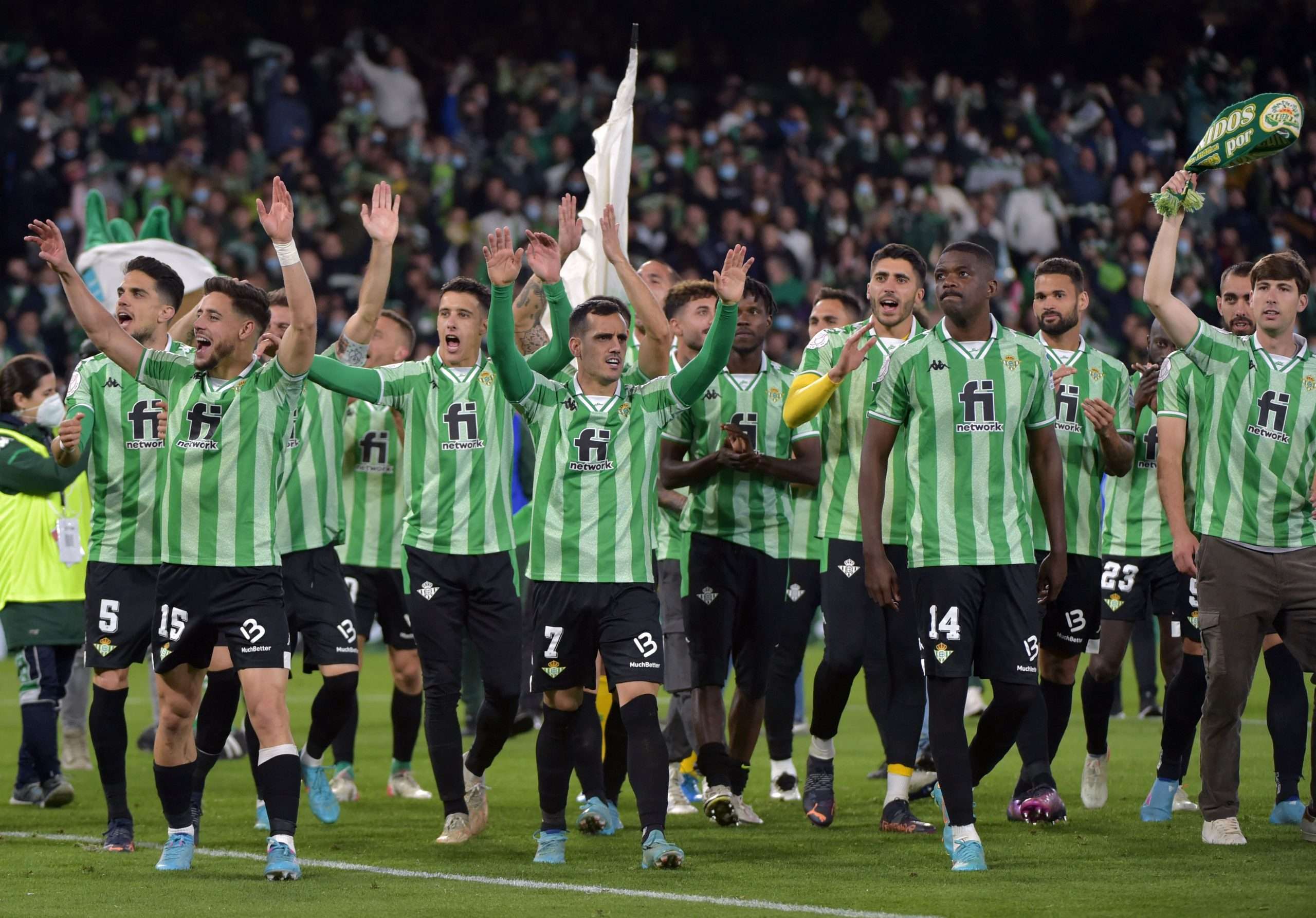The clock ticked past one minute beyond 90. Real Betis keeper Claudio Bravo picked out Joaquín with an inch-perfect diagonal ball from the edge of his own box. The veteran controls it with poise. He drifts past his marker before laying it forward for Sergio Canales. Seeing the opposition keeper sprint forward, Betis’ magician plays it square. Over 50,000 fanatics, draped in green and white, hold their breath. Borja Iglesias is beaten for pace by defender Fran García, but not for desire. A failed clearance is tapped home by the Galician striker. Thousands of Béticos across Andalusia erupt. Players and staff in the Betis dugout rush out to celebrate. What follows are moments of unfiltered emotion, of a fraternity in ecstasy. Screams, chants, songs, tears and smiles. Euphoric madness.
After 2005, Real Betis Balompié will play in the Copa del Rey final once again in 2022, and it is no more than they deserve. The final is now the chief mark of an imperiously talented Betis side, where the spells of players young and old have been concocted by Manuel Pellegrini into the most attractive football played in the country.
Betis’ 2021/22 Copa del Rey run has been spectacular, riding through highs and lows. They dispatched CFI Alicante 4-0 in the first round, before stumbling past third division Talavera with late goals in extra time. Valladolid were defeated comfortably next, but the tougher tests were to come.
The round of 16 served us Spanish football’s hottest derby – El Gran Derbi – Betis v Sevilla. In a packed Benito Villamarín, Sevilla took the lead. But Betis were more dominant, and they soon equalised. Nabil Fekir grabbed the game by the scruff of its neck, scoring directly from a corner. Betis’ genie produced a Golazo Olimpico and Betis seemed in rampant mood.
Terrible scenes followed as a miscreant threw a flagpole at Sevilla midfielder Joan Jordan. A shameful act of hooliganism overshadowed Spanish football’s best fixture. Sevilla refused to continue; the game was postponed, and the meltdown continued on Twitter where Betis players blamed their opposition for exaggerated theatrics. When the game resumed the following day, from minute 40, it was within an empty Villamarín. The riveting derby had been reduced to an atmosphere similar to a mere pre-season friendly. Betis nicked the winner and bragging rights in the city. On the whole, though, it was an ugly chapter in the history of Spain’s most brilliant derby.
Betis’ opposition would get no easier in the quarter-finals: Real Sociedad away. La Real, however, were in for a thrashing. Pellegrini’s green and white machine steamrolled their way through to the semi-finals. The scoreline: 4-0. The second 4-0 thumping that Betis had handed La Real this season. It was a statement performance by a mercurial Betis side. With the big 3 (Real Madrid, Barcelona, Atlético Madrid) all out of the competition, this high-flying Betis were suddenly the favourites.
Rayo Vallecano had to be overcome in the semis. Rayo have had a superlative season of their own, staying in the European spots for a long time in their first year back in the Primera, to go along with their Copa run. The two-legged semi against Rayo was yet another example of Pellegrini’s greatest achievement with Betis: the never-give-up attitude that he has instilled. At a club that runs by the philosophy ‘viva el Betis, manquepierda’ (‘Betis forever, even if we lose), Pellegrini has removed the despair of staring at defeat and developed a group that bounces back time and time again from losing situations. It has meant that Betis fought back to win 2-1 away after going a goal down in the first leg. It has meant that even after Bebé thundered home a free-kick of a lifetime to level at the scoreline, Betis kept on believing that victory was nigh. And so it proved to be.
Joaquín’s dribble, Canales’ pass, Borja’s finish: a perfect combination of everything that symbolizes this brilliant Betis side. Joaquín, an everlasting veteran with the elegance of a teenager; Canales, the talismanic figure on the pitch; and Borja, the ideal story of revival: a blend of players and abilities that has enabled Betis to become the most fascinating team in all of Spain this campaign.
In the 17 years between the two finals, Betis have faded into being predominantly the second best Andalusian team, having to fathom unprecedented European glory for rivals Sevilla. It has become a place where silverware doesn’t quite represent how gigantic the club is. But with its most brilliant group at hand, Betis are finally looking towards a piece of silverware to define this era.
Lastly, there must be an ode to Joaquín. A peek through social media would be enough to know what an enormous figure he is at Betis, arguably the club’s greatest ever. Nearing his 41st birthday, Joaquín has hinted at retirement. Having not started a league game this season, the cup competitions have been the floors of Joaquín’s last dance, and the recipients of his final moments of majesty. And he showed he was not done yet as he was the architect in the goal that sent Betis to the final.

Joaquín’s celebrations of his Copa titles are etched into Spanish football folklore. His first Copa triumph in 2005 (Betis’ most recent Copa) was the best man at his wedding. His second Copa triumph in 2008 with Valencia gave us a hilarious image for the ages. With another trophy waiting on the horizon, Joaquín is now preparing the next generation to celebrate in unique fashion. He quipped after the final, “I’m taking Diego Lainez to rehearse for when we lift the cup!”










